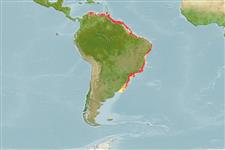Elasmobranchi (squali e razze) (sharks and rays) >
Carcharhiniformes (Ground sharks) >
Carcharhinidae (Requiem sharks)
Etymology: Rhizoprionodon: rhiza (Gr.), root; prion (Gr.) saw; odon (Gr.), tooth, referring to teeth with serrated (saw-like) bases, or roots [replacement name for Rhizoprion Ogilby 1915, preoccupied by Rhizoprion Jourdan 1861 in mammals]. (See ETYFish); lalandii: In honor of naturalist and explorer Pierre Antoine Delalande (1787-1823), who collected type [authorship often attributed to Müller & Henle, who published Valenciennes’ description]. (See ETYFish).
Environment: milieu / climate zone / depth range / distribution range
Ecologia
marino demersale; distribuzione batimetrica 3 - 70 m (Ref. 244). Tropical; 13°N - 35°S, 78°W - 31°W
Western Atlantic: Panama to southern Brazil and Uruguay (Ref. 58839).
Length at first maturity / Size / Peso / Age
Maturity: Lm 61.8, range 58 - ? cm
Max length : 80.0 cm TL (female); common length : 55.0 cm TL maschio/sesso non determinato; (Ref. 5217); peso massimo pubblicato: 0.00 g
Inhabits shallow coastal waters, on sandy and muddy bottoms, and not normally found in lagoons and estuaries (Ref. 244). Feeds on small bony fishes, including sardines and anchovies, also shrimp and squid (Ref. 244). Viviparous, with 1 to 4 young in a litter; size at birth 33 to 34 cm (Ref. 244). Its flesh is highly appreciated and is marketed dried salted.
Distinct pairing with embrace (Ref. 205). Viviparous, placental (Ref. 50449).
Compagno, L.J.V., 1999. Checklist of living elasmobranchs. p. 471-498. In W.C. Hamlett (ed.) Sharks, skates, and rays: the biology of elasmobranch fishes. Johns Hopkins University Press, Maryland. (Ref. 35766)
IUCN Red List Status (Ref. 130435)
Threat to humans
Harmless
Human uses
Pesca: commerciale
Strumenti
Special reports
Download XML
Fonti Internet
Estimates based on models
Preferred temperature (Ref.
123201): 24.6 - 28, mean 27.2 °C (based on 104 cells).
Phylogenetic diversity index (Ref.
82804): PD
50 = 0.5078 [Uniqueness, from 0.5 = low to 2.0 = high].
Bayesian length-weight: a=0.00269 (0.00177 - 0.00409), b=3.08 (2.96 - 3.20), in cm total length, based on LWR estimates for this species & Genus-body shape (Ref.
93245).
Trophic level (Ref.
69278): 4.3 ±0.65 se; based on food items.
Resilienza (Ref.
120179): Molto basso, tempo minimo di raddoppiamento della popolazione più di 14 anni (Fec=1).
Fishing Vulnerability (Ref.
59153): Moderate to high vulnerability (52 of 100).
